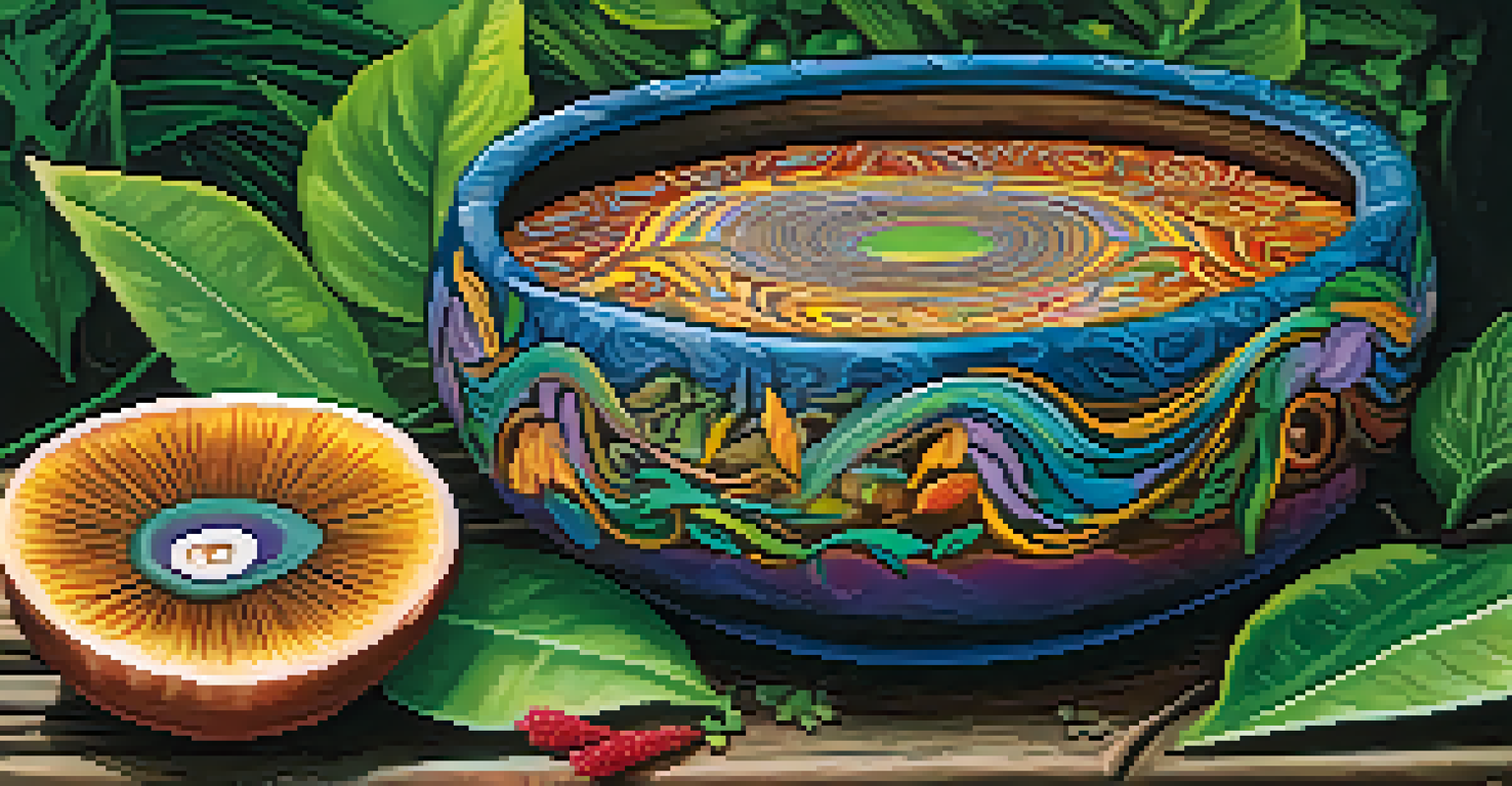Entheogens and Empathy: Strengthening the Therapeutic Bond

Understanding Entheogens: A Brief Overview
Entheogens are substances that induce altered states of consciousness, often used in spiritual or therapeutic contexts. They have been utilized across cultures for centuries, from ancient rituals to modern therapy sessions. By fostering deep introspection and connection, these substances can potentially enhance emotional experiences.
The greatest gift of human beings is that we have the power of empathy.
In therapeutic settings, entheogens like psilocybin and ayahuasca are gaining attention for their ability to promote empathy. This emotional connection can be crucial for healing, as it allows individuals to explore their feelings in a safe environment. Understanding the role of these substances can help demystify their therapeutic potential.
As we delve into the relationship between entheogens and empathy, it’s essential to recognize both the benefits and risks involved. Proper guidance and a supportive environment are key to ensuring a positive experience, allowing individuals to harness the potential of these substances.
The Science of Empathy and Its Importance in Therapy
Empathy is the ability to understand and share the feelings of another, and it plays a crucial role in effective therapy. When therapists can empathize with their clients, it creates a strong bond that fosters trust and openness. This connection can significantly enhance the therapeutic process.

Research shows that empathy in therapy can lead to better client outcomes, including reduced symptoms of anxiety and depression. When clients feel understood, they are more likely to engage in the therapeutic process and make meaningful progress. This highlights the importance of cultivating empathy in therapeutic settings.
Entheogens Enhance Emotional Healing
Entheogens can foster deep emotional connections, facilitating empathy and introspection in therapeutic settings.
However, empathy isn't always easy to achieve. Barriers such as personal biases, emotional exhaustion, and communication challenges can hinder a therapist's ability to connect deeply with clients. This is where entheogens might play a transformative role, helping both therapists and clients break down these barriers.
How Entheogens Facilitate Emotional Connections
Entheogens have the potential to deepen emotional connections by altering perception and enhancing feelings of unity. During a session, users often report heightened emotional awareness, which can lead to profound insights about themselves and their relationships. This can be particularly beneficial in a therapeutic context.
Empathy is about finding echoes of another person in yourself.
For instance, a client may experience a rush of empathy towards others, including their therapist, during an entheogenic experience. This newfound understanding can break down previously held defenses, allowing for more honest and open communication. Such moments can transform the therapeutic relationship into a truly collaborative journey.
Moreover, these substances can help clients access repressed emotions, facilitating a cathartic release that further strengthens the bond with their therapist. By creating a safe space for exploration, entheogens can help both parties navigate the complexities of emotional healing together.
Therapist Perspectives: Navigating the Entheogenic Experience
For therapists, incorporating entheogens into practice requires careful consideration and training. Understanding the nuances of these substances is essential for ensuring client safety and effective outcomes. Therapists must also be prepared to handle the emotional intensity that can arise during sessions.
Many therapists report that their own experiences with entheogens have enhanced their ability to empathize with clients. These personal insights can lead to a deeper understanding of the therapeutic process, allowing therapists to navigate challenging emotions with greater ease. This shared experience can foster a sense of camaraderie between therapist and client.
Empathy is Key in Therapy Success
A strong empathetic bond between therapists and clients significantly enhances therapeutic outcomes and client engagement.
However, it's vital for therapists to approach this practice with caution. Establishing clear boundaries and maintaining professional ethics are essential to prevent potential misuse of entheogens in therapy. When approached responsibly, the integration of these substances can lead to profound therapeutic breakthroughs.
Cultural Contexts: Entheogens in Traditional Practices
Throughout history, many cultures have utilized entheogens in rituals to foster empathy and connection. Indigenous communities often incorporate these substances into healing ceremonies, emphasizing the importance of community support and shared experience. Understanding these cultural practices can enrich modern therapeutic approaches.
For example, in many South American traditions, ayahuasca ceremonies focus on collective healing, where participants support each other through their journeys. This communal aspect can strengthen the therapeutic bond, providing a strong foundation of trust and empathy. Learning from these traditions can inform contemporary therapy practices.
Integrating cultural wisdom into modern therapy can enhance the effectiveness of entheogenic experiences. By respecting and valuing these traditions, therapists can create a more holistic approach to healing that resonates with diverse clients.
Challenges and Ethical Considerations in Entheogenic Therapy
While entheogens offer promising therapeutic potential, there are significant challenges and ethical considerations to address. Ensuring informed consent and understanding the risks associated with these substances is paramount for both therapists and clients. A thorough assessment of each individual's mental health history is essential.
Additionally, the legality of entheogenic substances varies widely, impacting their availability for therapeutic use. Therapists must navigate these legal landscapes carefully to ensure they are practicing ethically and responsibly. This can create barriers for some seeking this type of therapy, underscoring the need for ongoing dialogue and policy reform.
Cultural Wisdom Enriches Therapy
Integrating traditional practices involving entheogens can provide valuable insights and improve modern therapeutic approaches.
Ultimately, establishing best practices and guidelines for entheogenic therapy will be crucial as interest in this field continues to grow. Open discussions about the benefits and risks will help create a safe and effective environment for exploring these powerful substances.
The Future of Entheogens in Therapeutic Practices
As research into entheogens continues to expand, the future of their use in therapy looks promising. Studies are increasingly demonstrating their potential to enhance empathy and emotional connection, leading to improved therapeutic outcomes. This growing body of evidence is encouraging more therapists to explore these options.
Moreover, societal attitudes towards mental health and alternative therapies are shifting, creating more opportunities for integrating entheogens into traditional therapeutic practices. As stigma decreases, clients may feel more comfortable pursuing these innovative treatments, potentially leading to widespread acceptance.

In conclusion, the integration of entheogens in therapy has the potential to revolutionize how we approach mental health treatment. By strengthening the therapeutic bond through enhanced empathy, these substances could pave the way for deeper healing and understanding in the therapeutic relationship.